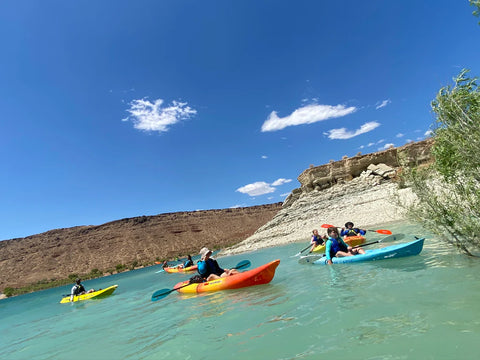Weather Information
Weather Information in Quail Creek State Park
Paddleboarding & Kayaking in Utah
We hold coaching certifications from WPA, PaddleFit, and our Dig Instructor Preparedness Program (DIPP). We have also lifeguarded hundreds of open-water triathlons and swim events, paddled creeks and shorelines in Costa Rica, Wyoming, Idaho, California, Arizona, Oklahoma, Florida, and Mexico. Our mission is to assist individuals in having the greatest possible time on the water. This is made possible by the use of high-quality gear and qualified instructors who have the necessary skill set and mentality, both of which we work hard to impart to all of our visitors.
Dig Paddlesports offers a fantastic group of instructors, employees, and volunteers that work together to make your regular rentals, purchases, family gatherings, dates, parties, and other special events a success. Utah's culture places a high value on outdoor leisure. We like swimming, boating, fishing, mountain biking, ATV riding, and other activities. Outdoor activities do, however, have certain inherent hazards.
Because we want to make sure that everyone has the best time on the water, it’s important to stay safe and learn about your surroundings. Read further about weather and safety precautions while paddleboarding and kayaking at Quail Creek State Park.

Utah’s Seasons
There are vast differences in the weather from Northern Utah to Southern Utah since Utah is a fairly big state that stretches from the N 42nd to the N 37th latitudinal parallel. Two extreme cold and heat records were set in Utah in 1985: -69.3 °F (-56 °C) at Peter Sinks in February and 117 °F (47 °C) in St. George in July.
The most favorable weather often occurs between late April and mid-June and late August to mid-October. Utah has four significant seasons with different weather patterns.
The climate of Southern Utah is typically dry, arid, and desert-like. It has one of the lowest relative humidity percentages and is one of the driest states in the nation. The average maximum relative humidity is 74.3 percent in December, while the average minimum relative humidity is 35.9 percent in July. In contrast to an area with high relative humidity, like Florida, which makes it seem hotter and muggier, 90 degrees Fahrenheit (32 C) in Utah feels considerably more bearable.
Summer begins in June with pleasant temperatures, lots of sunlight, and sporadic showers. The summer solstice, when June's longest days of the year peak at 15 hours of light, occurs. The hottest months of the year are July and August, which have similar average high temperatures. The least quantity of rain falls during these driest (least humid) months.
December through February is the winter season, which has prolonged snowfall, subfreezing temperatures, and short daylight hours. The winter months of December and January are the coldest. The day with the fewest daylight hours is December 21, often known as the winter solstice. With hints of higher temperatures and more sunshine, February weather is a combination of winter and spring.
On the other hand, we also get "dry cold," which means that since Utah lacks humidity, the air doesn't feel as icy during the worst weeks of winter as it does in areas like coastal New England. The sky over Utah is a richer hue of blue due to the absence of humidity and moisture in the environment.
We see an average of 14.54” of precipitation annually.
Poisonous Reptiles and Signs of Dehydration
When it comes to wildlife, leave it alone. You will probably never see a rattlesnake on the trail, but if you do, stay away from it.
However, everyone can become dehydrated quickly in the desert. When your body doesn't have enough water, dehydration occurs. Your body can't function effectively without enough water. Depending on how much bodily fluid is lost, dehydration can be mild, moderate, or severe. Our bodies lose water to evaporation from our skin and through breathing. We can usually restore it by drinking fluids regularly and consuming foods that contain water. On the water or on the trails, we need to stay hydrated.
Signs of dehydration include:
- Dry or sticky tongue or thirst
- Not urinating frequently
- Urine is dark yellow.
- Cool, dry skin
- Headache
- Muscle pain or cramps
Signs of Heat Stroke
Heat stroke is caused by prolonged exposure to high temperatures, frequently in conjunction with dehydration, which compromises the body's ability to regulate its internal temperature. A core body temperature of more than 104 degrees Fahrenheit, together with difficulties involving the central nervous system, is the medical definition of a heat stroke. Seizures, confusion, nausea, and possibly loss of consciousness or coma are other frequent symptoms.
Symptoms of heat stroke include:
- Severe headache
- Unsteadiness and faintness
- Despite the heat, not sweating
- Dry, heated, and irritated skin
- Weakened or cramping muscles
- Nausea
- Vomiting
- Rapid pulse that might be strong or weak
- Shallow, rapid breathing
- Changes in behavior such as disorientation or staggering
- Seizures
- Unconsciousness
Get into shade and out of direct sunlight, remove yourself from the source of heat, get cool
Contact Us TodayOur team is here for you to make sure you and your party have the best time possible. We share this information to keep everyone safe and knowledgeable while they enjoy a day on the water. If you have any questions, don’t hesitate to reach out to our friendly and helpful team! Contact us today for Kayak rentals and tours.

